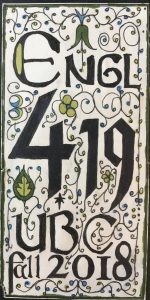
Most of the research done throughout the RBSC at UBC are here an adapted version from the original hand-written draft. To begin, I found that one of the most interesting things has the been very age of each of the books brought out throughout the semester, as well as those I myself had called up. One to note here is a copy of a book written by Mary Shelley. In the back pages of the vol. book, The Last Man, there was an advertisement for some of the other newly published books written by Mary Shelley. This was surely an interesting book to have the opportunity to flip through.
Shackell, Arrowsmith, & Hodges, Johnsons Court, Fleet Street. A London based publisher had produced the book mentioned above. Another great encounter was a book written by Tolstoy, Anna Karenina, which was also available at the RBSC at UBC. A copy from 1914 to be exact. Though not my favorite encounter in the collection, however, remarkable.
The collection of maps, in particular those from the Tokugawa Era, are exquisite. The use of color is amazing, and the sheer time it must have taken to complete not only the maps but the books is absurd. Each compiling of a book or a collection of maps has been completed by a master ‘craftsman’ and must have taken months or years to complete. A person’s livelihood was maintained by creating works of quality and the knowledge they had of the world.
Another great aspect of the books in the collections has been the use of bookplates, such as the one mentioned in the Blog posted here on Anna Karenina. The use and ranging qualities of paper is something unique to each book and made each book more unique. Of course, the quality of paper reflects the price and overall quality of the book, however, it may also represents the artists desires. To create a different experience for the reader via paper type.
It was strange to find that most of the works were from varying places in Europe, however, after considering the time in history when each object was created it isn’t so surprising. I found the politics of the book interesting and wonder what the global landscape of the book was like during those times.
To think there were people travelling extremely far distances for extended periods of time – due to the friction of distance – to just sell or buy books. Or might have it been simply through capitalist practices of trade that books became simply another resource to exchange for other resources. The use of different colors to create a marbled cover or embellishments on pages is incredible. I found it hard to trace back to find when its use became popularized. Nonetheless, each book I encountered has sparked curiosity.
It is possible to also see that at the time these books were created, that although people may have still been illiterate, people had better reading skills. This thought runs alongside the first quote presented in 5 Selected Readings. Currently, technology has advanced to a degree that has catapulted its use by people day to day and which has in turn driven the population to be largely bad readers and people that cannot simply pay attention to a book or something for an extended period of time.
Distracted people is the world today. Even walking down the street or waiting in traffic in a busy urban area, it is possible to see hundreds of people distracted by technologies of all scales. In part, this not only leads to poor readers, but a general population that does not care about significant artifacts of human existence, aside the smart phone. It is a given that people are more inclined, at least in Vancouver, to enjoy those ‘relics’ that is fashion forward and trendy today, but overall, the greater population has no regard for literature or reading.
I found the third selected sentence interesting as it questions the ‘eye’ of the ordinary reader. However, today, the ordinary reader does not exist. In short, I believe in the future, there will be even less reading of books and content heavy literature. Instead people are retraining their eye to be able to see cracks on their screen. Even still, people are more critical about the technology itself, the new and faster smart phone, the ergonomic proportions and not the typeface used in the PDF files they download for free or literary methods and techniques writing.
Society has become full of consumers and less innovators. The fourth sentence provokes thoughts about the state of the artist. As innovator, the book creators worked tirelessly to create a work for a client. Adding and experimenting with page, font, scale, and so on. There is no question that the past people creating books were innovators, however, are we still innovators? The book has become a relic and one that is static. We may use new technologies to recreate or ‘innovate’ the book, however, we have only immortalized a previous innovation, and have not truly found a new ‘morphosis’ of the book as did those in the past.
The last selected sentence is one that brings about thoughts of the future of the book and in part, bibliography. Our technologies will surely allow for books to be easily produced, however, will we come to innovate the way we read and interpret type? Societies complex social processes are no longer compatible with the book. Possible an E-book where links to major apps supplement ones reading experience.
In all, the selected sentences are meant to all together direct thoughts about the future and current state of the book. Will there be in the future classes looking at relics from 2018? or will the current manuscripts from the time of Chaucer be it? Will there be people exploring the innovative and creative ways we have adapted the book to the current generations needs and desires. In this sense, will only those books published pre-1900 be the catalog of world libraries. Will books hold the same amount of character and energy as do those within the RBSC at UBC? Or will it simply be a library full of dusty tablets from generations past?
